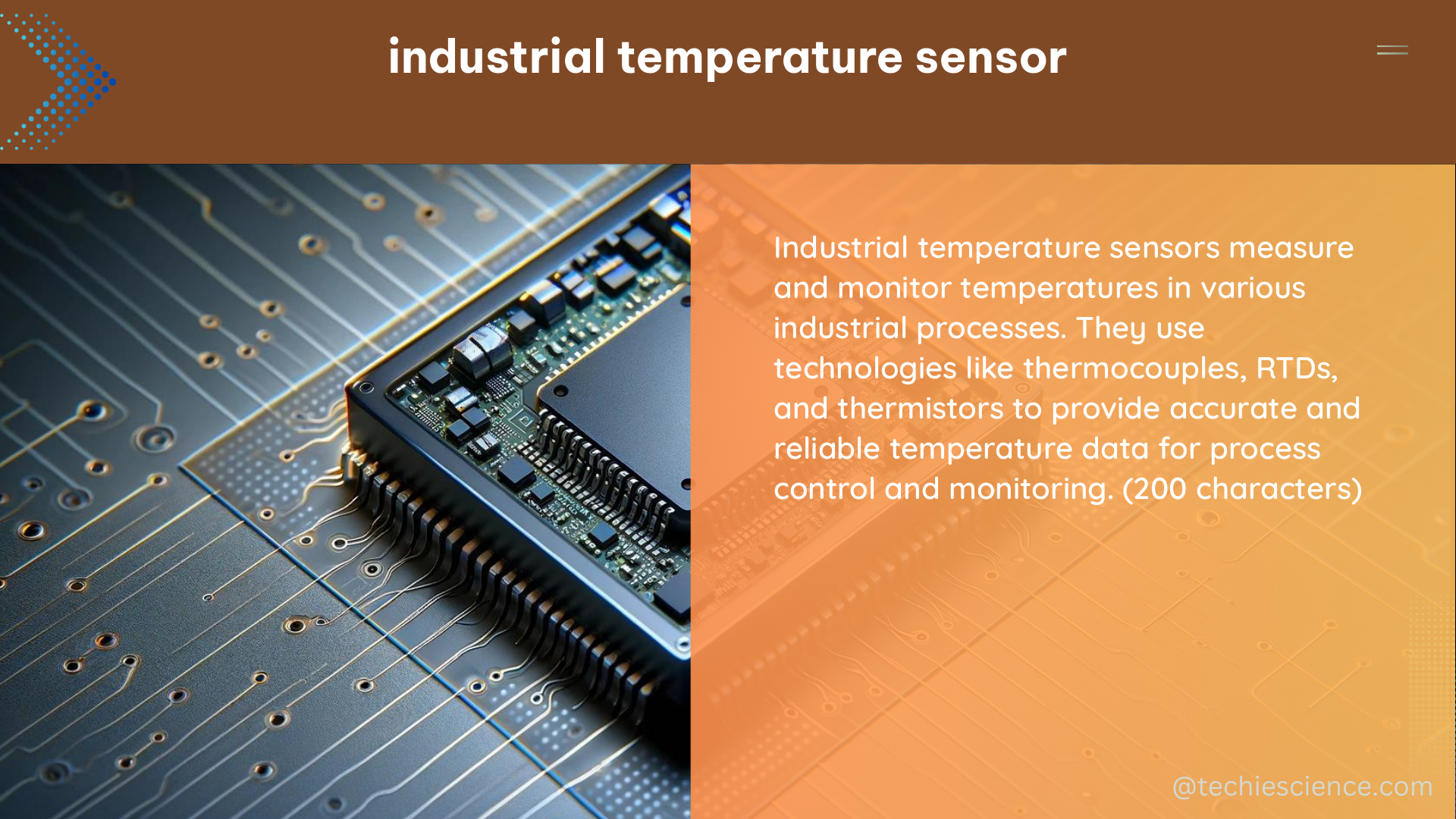Industrial temperature sensors are critical components in various applications, including chemical engineering, manufacturing, and process control. These sensors measure temperature by detecting changes in physical properties such as volume, current, or resistance. The three main types of temperature sensors are thermometers, resistance temperature detectors (RTDs), and thermocouples.
Thermometers
Thermometers measure temperature by comparing the volume of a liquid (usually mercury or alcohol) in a sealed tube with a known volume at a reference temperature. The most common types of thermometers used in industrial applications are:
-
Mercury Thermometers: These thermometers use the expansion of mercury to measure temperature. They have a temperature range of -38°C to 350°C (-36.4°F to 662°F) and an accuracy of ±0.1°C (±0.18°F).
-
Alcohol Thermometers: These thermometers use the expansion of alcohol to measure temperature. They have a temperature range of -100°C to 80°C (-148°F to 176°F) and an accuracy of ±0.5°C (±0.9°F).
-
Bimetallic Thermometers: These thermometers use the differential expansion of two different metals to measure temperature. They have a temperature range of -50°C to 500°C (-58°F to 932°F) and an accuracy of ±1°C (±1.8°F).
Resistance Temperature Detectors (RTDs)

RTDs measure temperature by detecting changes in the electrical resistance of a wire made of a material with a known temperature coefficient of resistance. The most common types of RTDs used in industrial applications are:
-
Platinum RTDs: These RTDs use a platinum wire as the sensing element. They have a temperature range of -200°C to 850°C (-328°F to 1,562°F) and an accuracy of ±0.1°C (±0.18°F).
-
Copper RTDs: These RTDs use a copper wire as the sensing element. They have a temperature range of -200°C to 200°C (-328°F to 392°F) and an accuracy of ±0.5°C (±0.9°F).
-
Nickel RTDs: These RTDs use a nickel wire as the sensing element. They have a temperature range of -80°C to 320°C (-112°F to 608°F) and an accuracy of ±0.2°C (±0.36°F).
Thermocouples
Thermocouples measure temperature by generating a voltage proportional to the temperature difference between two junctions of dissimilar metals. The most common types of thermocouples used in industrial applications are:
-
Type K Thermocouples: These thermocouples use chromel (nickel-chromium alloy) and alumel (nickel-aluminum alloy) as the dissimilar metals. They have a temperature range of -200°C to 1,372°C (-328°F to 2,502°F) and an accuracy of ±1.5°C (±2.7°F).
-
Type J Thermocouples: These thermocouples use iron and constantan (copper-nickel alloy) as the dissimilar metals. They have a temperature range of -210°C to 1,200°C (-346°F to 2,192°F) and an accuracy of ±2.2°C (±4°F).
-
Type T Thermocouples: These thermocouples use copper and constantan as the dissimilar metals. They have a temperature range of -270°C to 400°C (-454°F to 752°F) and an accuracy of ±0.5°C (±0.9°F).
Other Temperature Sensors
In addition to the three main types of temperature sensors, there are other temperature sensors available, such as:
-
Infrared Thermometers: These sensors measure temperature by detecting the infrared radiation emitted by an object. They have a temperature range of -50°C to 2,000°C (-58°F to 3,632°F) and an accuracy of ±1% of the reading or ±1°C (±1.8°F), whichever is greater.
-
Thermistors: These are temperature-sensitive resistors that change resistance with temperature. They have a temperature range of -100°C to 300°C (-148°F to 572°F) and an accuracy of ±0.1°C (±0.18°F).
-
Fiber Optic Sensors: These sensors measure temperature by detecting changes in the optical properties of a fiber optic cable. They have a temperature range of -200°C to 800°C (-328°F to 1,472°F) and an accuracy of ±0.1°C (±0.18°F).
Industrial Temperature Sensor Networks and Challenges
Industrial temperature sensors are often used in networks, requiring strategies for managing traceability, calibration, verification, and drift monitoring. Smart sensors that can self-calibrate and report irregularities are being developed to enhance traceability and minimize downtime.
Spatial resolution remains a challenging area in distributed sensing and thermal imaging, and the effects of the measurement environment on sensor uncertainty need further study for all sensors. Factors such as vibration, electromagnetic interference, and harsh environmental conditions can significantly impact the accuracy and reliability of industrial temperature sensors.
Conclusion
Industrial temperature sensors are critical components in various applications, and selecting the appropriate sensor requires considering the temperature range, accuracy, response time, and environmental factors. Advances in smart sensors and data fusion techniques offer significant potential for improving temperature measurement accuracy and reducing downtime in industrial settings.
References:
– Review of Industrial Temperature Measurement Technologies and Research Priorities, Core.ac.uk, 2021.
– Temperature Sensors, Engineering LibreTexts, 2023.
– Evaluating the use of a temperature sensor to monitor spectacle compliance for future application in research, National Center for Biotechnology Information, 2018.
– Sensor System – an overview, ScienceDirect Topics, 2021.
– Industrial Temperature Measurement, LinkedIn, 2017.

The lambdageeks.com Core SME Team is a group of experienced subject matter experts from diverse scientific and technical fields including Physics, Chemistry, Technology,Electronics & Electrical Engineering, Automotive, Mechanical Engineering. Our team collaborates to create high-quality, well-researched articles on a wide range of science and technology topics for the lambdageeks.com website.
All Our Senior SME are having more than 7 Years of experience in the respective fields . They are either Working Industry Professionals or assocaited With different Universities. Refer Our Authors Page to get to know About our Core SMEs.